Themed collection Editor’s Choice: Malika Jeffries-EL

High-throughput virtual screening for organic electronics: a comparative study of alternative strategies
We review how high throughput virtual screening can been used to navigate the landscape of materials for organic electronics.

J. Mater. Chem. C, 2021,9, 13557-13583
https://doi.org/10.1039/D1TC03256A
A review of functional linear carbon chains (oligoynes, polyynes, cumulenes) and their applications as molecular wires in molecular electronics and optoelectronics
This review presents the multi-faceted applications of oligoynes in molecular electronics and optoelectronics, as well as recent insights for the design and properties of sp-hybridised carbon wires.

J. Mater. Chem. C, 2021,9, 10524-10546
https://doi.org/10.1039/D1TC01406D
Organic light emitting diodes (OLEDs) with slot-die coated functional layers
In this review article we cover the progress towards slot-die coated organic light emitting diodes (OLEDs). We showcase how emitting layers, charge transport layers, and electrodes can be slot-die coated to deliver practical OLED devices.
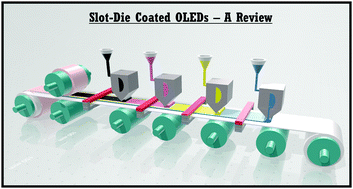
Mater. Adv., 2021,2, 628-645
https://doi.org/10.1039/D0MA00903B
Metal organic frameworks for adsorption-based separation of fluorocompounds: a review
In this article, we review the advancement of metal organic frameworks in terms of their adsorption capacity, selectivity and regenerability for the adsorption-based separation of fluorocompounds.
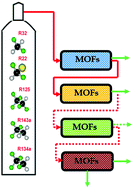
Mater. Adv., 2020,1, 310-320
https://doi.org/10.1039/D0MA00083C
A cell membrane-targeting AIE photosensitizer as a necroptosis inducer for boosting cancer theranostics
A membrane-targeting photosensitizer TBMPEI with AIE properties was synthesized via a new acceptor, and it was utilized as a necroptosis inducer during imaging-guided photodynamic therapy.
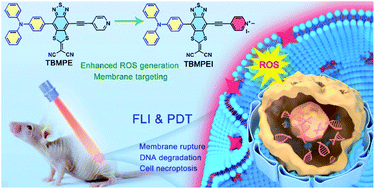
Chem. Sci., 2022,13, 5929-5937
https://doi.org/10.1039/D2SC01260J
Detection of multi-reference character imbalances enables a transfer learning approach for virtual high throughput screening with coupled cluster accuracy at DFT cost
We demonstrate that cancellation in multi-reference effect outweighs accumulation in evaluating chemical properties. We combine transfer learning and uncertainty quantification for accelerated data acquisition with chemical accuracy.
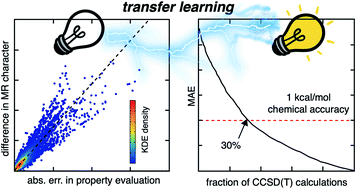
Chem. Sci., 2022,13, 4962-4971
https://doi.org/10.1039/D2SC00393G
Porphyrin-based donor–acceptor COFs as efficient and reusable photocatalysts for PET-RAFT polymerization under broad spectrum excitation
Porphyrin-based donor–acceptor COFs are effective heterogeneous photocatalysts for photoinduced electron transfer-reversible addition–fragmentation chain transfer (PET-RAFT), including for aqueous polymerizations and under red-light excitation.

Chem. Sci., 2021,12, 16092-16099
https://doi.org/10.1039/D1SC05379E
Physically inspired deep learning of molecular excitations and photoemission spectra
A physically-inspired machine learning model for orbital energies is developed that can be augmented with delta learning to obtain photoemission spectra, ionization potentials, and electron affinities with experimental accuracy.
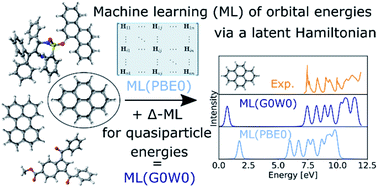
Chem. Sci., 2021,12, 10755-10764
https://doi.org/10.1039/D1SC01542G
Combining machine learning and high-throughput experimentation to discover photocatalytically active organic molecules
We developed models to predict the photoactivity of organic molecules for photocatalytic hydrogen evolution by integrating experiment, computation, and machine learning. This marks a step toward the data-driven discovery of molecular photocatalysts.
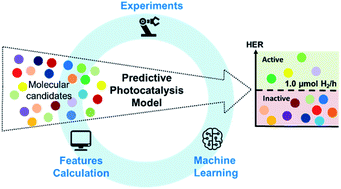
Chem. Sci., 2021,12, 10742-10754
https://doi.org/10.1039/D1SC02150H
Data-efficient machine learning for molecular crystal structure prediction
Using a cluster-based training scheme and a physical baseline, data efficient machine-learning models for crystal structure prediction are developed, enabling accurate structural relaxations of molecular crystals with unprecedented efficiency.
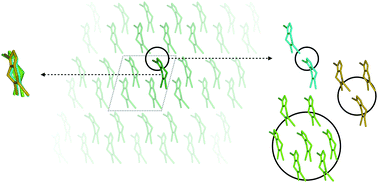
Chem. Sci., 2021,12, 4536-4546
https://doi.org/10.1039/D0SC05765G
Electrical conductivity in a non-covalent two-dimensional porous organic material with high crystallinity
Ultrathin porous films held together by non-covalent van der Waals interactions was obtained by a top-down approach, which is then utilized as channel material in a two-dimensional planar field-effect transistor device through easy stamp transfer.
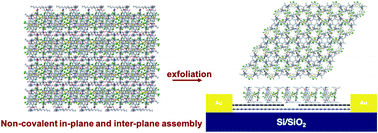
Chem. Sci., 2021,12, 2955-2959
https://doi.org/10.1039/D0SC05602B
One class classification as a practical approach for accelerating π–π co-crystal discovery
Machine learning using one class classification on a database of existing co-crystals enables the identification of co-formers which are likely to form stable co-crystals, resulting in the synthesis of two co-crystals of polyaromatic hydrocarbons.

Chem. Sci., 2021,12, 1702-1719
https://doi.org/10.1039/D0SC04263C
Highly efficient non-doped blue fluorescent OLEDs with low efficiency roll-off based on hybridized local and charge transfer excited state emitters
A new pure fluorescent blue HLCT-emitter was designed and synthesized. Highly efficient non-doped blue OLEDs with low efficiency roll-off were achieved.
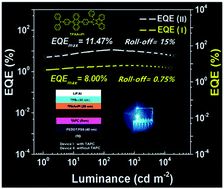
Chem. Sci., 2020,11, 5058-5065
https://doi.org/10.1039/D0SC01341B
Open-circuit-voltage shift of over 0.5 V in organic photovoltaic cells induced by a minor structural difference in alkyl substituents
The cause of a large shift in open-circuit voltage induced by a minor difference in end-alkyl groups of p-type small molecules is examined via X-ray diffraction and computation, revealing a critical impact of molecular packing.
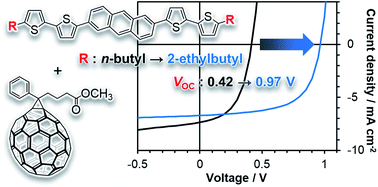
Chem. Sci., 2020,11, 1825-1831
https://doi.org/10.1039/C9SC04956H
Exploiting the versatile alkyne-based chemistry for expanding the applications of a stable triphenylmethyl organic radical on surfaces
Triphenylmethyl organic radicals functionalized with terminal alkyne groups open new avenues for their implementation as multifunctional surfaces.
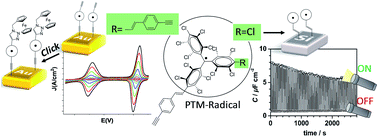
Chem. Sci., 2020,11, 516-524
https://doi.org/10.1039/C9SC04499J
Theoretical insights into molecular design of hot-exciton based thermally activated delayed fluorescence molecules
We examine and analyse the core concepts in molecular design for hot-exciton-based TADF molecules using DFT methods. We demonstrated the structure-property relationships and suggested a design strategy for producing multiple hot-exciton channels to improve RISC efficiency.

Mater. Adv., 2022,3, 4954-4963
https://doi.org/10.1039/D2MA00039C
A computational and experimental investigation of deep-blue light-emitting tetraaryl-benzobis[1,2-d:4,5-d′]oxazoles
In an effort to design deep-blue light emitting materials for use in OLEDs, the optical and electronic properties of a series of tetraarylbenzobis[1,2-d:4,5-d′]oxazole (BBO) cruciforms were evaluated using density functional theory (DFT) and time-dependent DFT (TD-DFT).
![Graphical abstract: A computational and experimental investigation of deep-blue light-emitting tetraaryl-benzobis[1,2-d:4,5-d′]oxazoles](/en/Image/Get?imageInfo.ImageType=GA&imageInfo.ImageIdentifier.ManuscriptID=D1MA00990G&imageInfo.ImageIdentifier.Year=2022)
Mater. Adv., 2022,3, 3842-3852
https://doi.org/10.1039/D1MA00990G
Boron-based non-fullerene small molecule acceptors via nitrogen substitution: a theoretical study
Theoretical calculations show that new boron-based acceptors with nitrogen substitution lead to enhanced electron mobility, and improved light-absorption and interfacial properties which are helpful for performances of organic solar cells.

Mater. Adv., 2022,3, 3229-3237
https://doi.org/10.1039/D1MA01010G
Aggregation induced delayed green fluorescence from assembly of gold nanoclusters: an advanced probe for “background free” pyrophosphate recognition
Aggregation induced emission based delayed fluorescence from assembly of gold clusters for sensing of pyrophosphate.

Mater. Adv., 2022,3, 3286-3292
https://doi.org/10.1039/D1MA01095F
Energy transfer processes in hyperfluorescent organic light-emitting diodes
In an efficient hyperfluorescent ternary blend, most of the singlet excitons from the TADF sensitizers will efficiently transfer to the emitters while the triplet excitons will first undergo a reverse intersystem crossing transition.
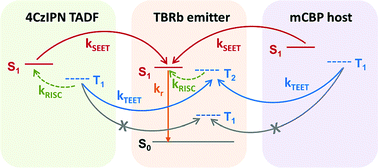
J. Mater. Chem. C, 2022,10, 4629-4636
https://doi.org/10.1039/D1TC05090G
Rapid predictions of the colour purity of luminescent organic molecules
Designing luminescent organic materials exhibiting narrowband emission is crucial for achieving high resolution and energy efficient organic light emitting diodes (OLEDs), but remains a significant challenge.
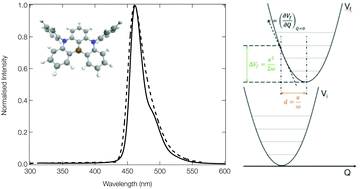
J. Mater. Chem. C, 2022,10, 4785-4794
https://doi.org/10.1039/D1TC04748E
Solution-processable phenothiazine and phenoxazine substituted fluorene cored nanotextured hole transporting materials for achieving high-efficiency OLEDs
In this work, a novel series of phenothiazine and phenoxazine substituted fluorene core-based solution-processable nanotextured HTMs was reported. Of these, the phenoxazine material showed a superior performance in phosphorescent yellow and TADF green OLEDs.

J. Mater. Chem. C, 2022,10, 3593-3608
https://doi.org/10.1039/D1TC05237C
Packing structures of (trialkylsilyl)ethynyl-substituted dinaphtho[2,3-b:2′,3′-f]thieno[3,2-b]thiophenes (DNTTs): effects of substituents on crystal structures and transport properties
Novel (trialkylsilyl)ethynyl-substituted DNTT derivatives are synthesized, and their crystal structures, transport properties, and the structure–property relationship are elucidated.
![Graphical abstract: Packing structures of (trialkylsilyl)ethynyl-substituted dinaphtho[2,3-b:2′,3′-f]thieno[3,2-b]thiophenes (DNTTs): effects of substituents on crystal structures and transport properties](/en/Image/Get?imageInfo.ImageType=GA&imageInfo.ImageIdentifier.ManuscriptID=D1TC04312A&imageInfo.ImageIdentifier.Year=2022)
J. Mater. Chem. C, 2022,10, 2775-2782
https://doi.org/10.1039/D1TC04312A
Acenaphthene-triphenylamine (acceptor–donor) based luminophores for organic light emitting diodes: combined experimental and theoretical study
A series of acenaphthene derivatives were designed and synthesized by incorporating acenaphthene-imidazole as an electron-transporting moiety and triphenylamine (TPA) as a hole-transporting moieties. All the dyes showed a broad bluish-white to yellowish-orange emission with emission maxima in the range of 520–600 nm.
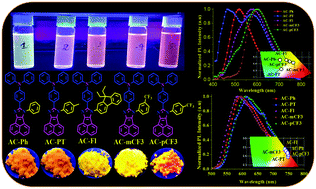
Mater. Adv., 2022,3, 399-408
https://doi.org/10.1039/D1MA00583A
Phenanthroimidazole-based bipolar carbazoles featuring cyano substituents to realize efficient deep-blue electroluminescence with an external quantum efficiency of nearly 6%
Organic emitters comprising carbazole and phenanthroimidazole with tunable optical and electronic properties due to the position and number of cyano substituents on the carbazole core are described.

Mater. Adv., 2021,2, 6326-6338
https://doi.org/10.1039/D1MA00604E
What is special about silicon in functionalised organic semiconductors?
Atomic substitution in sidechains of an organic semiconductor show these solubilizing groups are not simple spectators. Silicon is the most electron withdrawing group 14 element, increasing photostability and offering desirable crystal packing.

Mater. Adv., 2021,2, 5415-5421
https://doi.org/10.1039/D1MA00447F
A–π–A, D–π–D and D–π–A blue emitting fluorophores based on dispiro[fluorene-9,6′-indeno[1,2-b]fluorene-12′,9′′-fluorene]
We report a series of blue fluorophores based on the dispiro[fluorene-9,6′-indeno[1,2-b]fluorene-12′,9′′-fluorene] (DSF-IF) scaffold.
![Graphical abstract: A–π–A, D–π–D and D–π–A blue emitting fluorophores based on dispiro[fluorene-9,6′-indeno[1,2-b]fluorene-12′,9′′-fluorene]](/en/Image/Get?imageInfo.ImageType=GA&imageInfo.ImageIdentifier.ManuscriptID=D0MA00875C&imageInfo.ImageIdentifier.Year=2021)
Mater. Adv., 2021,2, 1271-1283
https://doi.org/10.1039/D0MA00875C
In silico design of 2D polymers containing truxene-based platforms: insights into their structural and electronic properties
A total of 27 different 2D truxene-based polymers were theoretically investigated. Our results provide interesting guidelines to design novel 2D materials with applications ranging from sensing to photocatalysis or electronics.
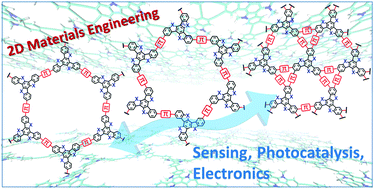
J. Mater. Chem. C, 2020,8, 15416-15425
https://doi.org/10.1039/D0TC03139A
Engineering functionalized low LUMO [1]benzothieno[3,2-b][1]benzothiophenes (BTBTs): unusual molecular and charge transport properties
A unique molecular library of functionalized low LUMO BTBT semiconductors was developed and studied in detail to reveal key design principles for electron transport in DAcTTs.
![Graphical abstract: Engineering functionalized low LUMO [1]benzothieno[3,2-b][1]benzothiophenes (BTBTs): unusual molecular and charge transport properties](/en/Image/Get?imageInfo.ImageType=GA&imageInfo.ImageIdentifier.ManuscriptID=D0TC02945A&imageInfo.ImageIdentifier.Year=2020)
J. Mater. Chem. C, 2020,8, 15253-15267
https://doi.org/10.1039/D0TC02945A
The effect of aromatic ring size in electron deficient semiconducting polymers for n-type organic thermoelectrics
N-type semiconducting polymers have been recently utilized in thermoelectric devices, however they have typically exhibited low electrical conductivities and poor device stability, in contrast to p-type semiconductors, which have been much higher performing.
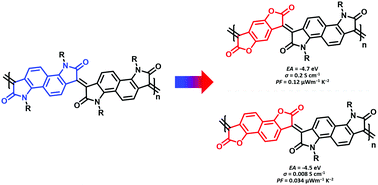
J. Mater. Chem. C, 2020,8, 15150-15157
https://doi.org/10.1039/D0TC03347B
Synthesis and photoswitchable amphiphilicity and self-assembly properties of photochromic spiropyran derivatives
H-Aggregate formation of photochromic spiropyran derivatives via photoswitchable amphiphilicity.
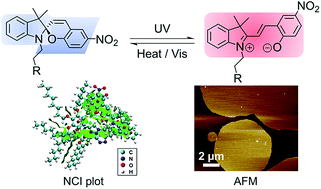
J. Mater. Chem. C, 2020,8, 13676-13685
https://doi.org/10.1039/D0TC03301D
About this collection
In 2022, Chemical Science welcomed Professor Malika Jeffries-EL to the journal as an Associate Editor, handling papers in the area of functional organic materials. Malika’s research interest include the design and synthesis of organic semiconductors for use in applications including solar cells, transistors and organic light emitting diodes. Prior to joining the Chemical Science team, she served as an Associate Editor for Journal of Materials Chemistry C and Materials Advances. For this editor’s choice collection, she has selected some outstanding articles that were published in Chemical Science, Journal of Materials Chemistry C, or Materials Advances in the last two years. She has always been excited by chemistries that push the boundaries in the pursuit of complex materials and the optimization of their properties. The selection features experimental and theoretical work leading to new materials for use in a range of applications. We hope you enjoy reading through this selection.